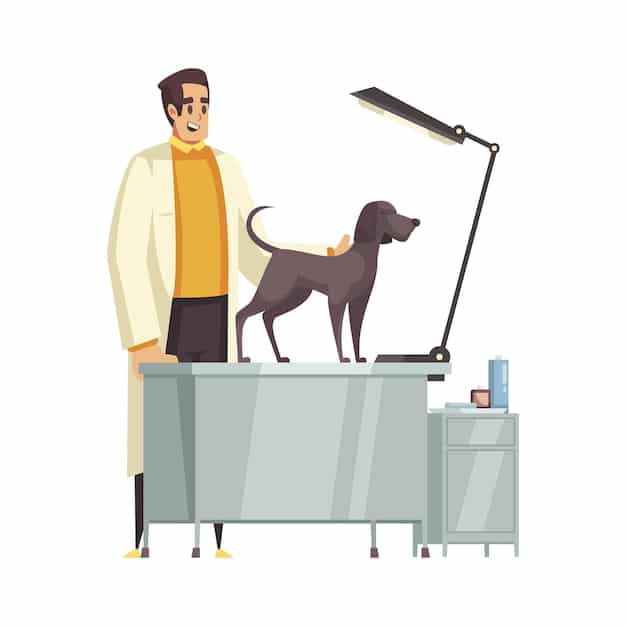Cancer in Pets: Types, Treatments, and Prognosis Explained

Cancer in pets is a significant health concern, but understanding the different types, treatment options like surgery and chemotherapy, and potential prognoses can help pet owners make informed decisions and provide the best possible care.
Discovering a diagnosis of cancer in pets can be devastating for any pet owner. However, understanding the disease, available treatments, and potential outcomes can empower you to make informed decisions and provide the best possible support for your furry companion. This comprehensive guide will explore the various aspects of cancer in pets, offering insights into different types, treatment options, and what to expect in terms of prognosis.
Understanding Cancer in Pets
Cancer is a broad term encompassing a group of diseases characterized by the uncontrolled growth and spread of abnormal cells. Just like humans, pets can develop various types of cancer, each with its own unique characteristics and treatment approaches. Understanding the basics of this illness in our beloved companions can significantly impact its prognosis.
Early detection and intervention are crucial in managing cancer in pets. Regular veterinary check-ups, awareness of potential signs and symptoms, and prompt action can improve the chances of successful treatment and extend the pet’s quality of life.

Common Types of Cancer in Pets
Cancer manifests in myriad forms, impacting different organs and systems within a pet’s body. Recognizing the prevalent types of cancer helps owners and vets target diagnosis, management, and potential interventions. Here we’ll delve into some of the most frequently observed cancers in domestic animals.
From lymphomas to osteosarcomas, the range of cancerous ailments affecting pets is extensive. Grasping the details of these ailments is pivotal for appropriate care, informed resolutions, and fortifying the chances of a positive outcome for afflicted animals.
Lymphoma
Lymphoma is a cancer of the lymphocytes, a type of white blood cell crucial for the immune system. It’s one of the most common cancers in dogs and cats.
Osteosarcoma
Osteosarcoma is a type of bone cancer, primarily affecting large and giant breed dogs. It’s an aggressive tumor that can cause significant pain and lameness.
- Mast Cell Tumors: These are common skin tumors in dogs and can vary in severity.
- Mammary Tumors: Common in unspayed female dogs and cats, these tumors can be benign or malignant.
- Melanoma: This is a type of skin cancer that can be benign or malignant.
- Hemangiosarcoma: An aggressive cancer of the blood vessels which primarily affects the spleen, liver, and heart.
Recognizing these common types of cancer and their signs is crucial for early detection and intervention in pets.
Diagnosis and Staging of Cancer in Pets
Accurate diagnosis and staging are critical steps in managing cancer in pets. These processes help determine the type and extent of the cancer, guiding treatment decisions and providing insights into prognosis. Multiple diagnostic methods are used in the detection of cancer.
Diagnostic methodologies span an array of approaches, including imaging techniques, tissue assessment, biochemical analyses, and specialized explorations. In concert, these components furnish a comprehensive comprehension of the disease and its degree of advancement, thereby equipping veterinarians to tailor treatment regimens for each unique situation.
Diagnostic Techniques
Several non-invasive and invasive techniques are used to diagnose cancer in pets.
Staging
Staging refers to determining the extent of the cancer, including the size of the tumor and whether it has spread to other parts of the body.
- Physical Examination: A thorough physical exam is the first step in assessing a pet for cancer.
- Blood Tests: These can help identify abnormalities in organ function or the presence of cancer cells.
- Imaging (X-rays, Ultrasound, CT Scans, MRI): These techniques allow veterinarians to visualize internal organs and detect tumors.
- Biopsy: A biopsy involves taking a sample of tissue for microscopic examination to confirm the presence of cancer cells.
Combining diagnostic imaging, biopsy, and staging information provides a comprehensive overview of the cancer, enabling veterinarians to formulate an effective treatment plan.

Treatment Options for Cancer in Pets
Numerous treatment strategies are available to address cancer in pets, spanning surgery, chemotherapy, radiotherapy, targeted interventions, and palliative measures. The selection of the most suitable approach hinges on factors like the tumor’s type, advancement, and location, as well as the pet’s health parameters.
In many instances, a multimodal approach melding diverse treatment modalities yields optimal results. Open communication between the veterinarian and pet owners is crucial in navigating treatment decisions, considering each option’s prospective benefits and detriments, and formulating a regimen precisely aligned with the pet’s individual requirements.
Surgery
Surgical removal of the tumor is often the first line of treatment for localized cancers.
Chemotherapy
Chemotherapy involves using drugs to kill cancer cells or slow their growth, often used for systemic cancers like lymphoma.
- Radiation Therapy: Using high-energy rays to target and kill cancer cells.
- Targeted Therapy: Medications designed to target specific molecules involved in cancer growth.
- Immunotherapy: Stimulating the pet’s immune system to fight cancer cells.
- Palliative Care: Measures to relieve pain and improve quality of life in pets with advanced cancer.
The approach to treatment depends on the specifics of the type and stage of the cancer, combining medical treatments with supportive care for the pet’s well-being.
Prognosis and Quality of Life
The prognosis for pets with cancer varies widely depending on the type of cancer, its stage, and the treatment response. While some cancers may be curable, others may only be manageable to improve the pet’s quality of life.
Quality-of-life considerations are paramount when addressing cancer in pets. Veterinarians and pet owners collaborate closely to formulate a strategy that harmonizes effective treatment with preserving the pet’s comfort, joy, and overall well-being. This entails vigilantly monitoring for treatment-related adversities, proactively overseeing pain, and customizing treatment regimens to cater to the pet’s evolving requirements.
Factors Affecting Prognosis
Several factors influence the prognosis of cancer in pets.
Palliative Care and Supportive Therapy
Even when a cure is not possible, palliative care and supportive therapy can significantly improve a pet’s quality of life.
- Cancer Type and Stage: More aggressive cancers and those that have spread have a poorer prognosis.
- Treatment Response: Pets that respond well to treatment may have a longer survival time.
- Overall Health: The pet’s general health and age can also impact prognosis.
- Pain Management: Medications and therapies to relieve pain and improve comfort.
Understanding the factors affecting prognosis allows pet owners to make informed decisions and focus on maximizing their pet’s comfort and happiness.
Prevention and Early Detection
While not all cancers are preventable, certain lifestyle choices and proactive measures can lower the risk. Early detection is crucial for improving treatment outcomes and extending a pet’s life.
Nurturing a wholesome outlook, promoting proactive protocols, and securing regular veterinary assessments synergistically augment prospects for detecting cancers in their nascent phases. Pet guardians are incentivized to vigilantly regard their animals for any anomalous indicators, promptly engaging with the veterinarian should concerns emerge.
Preventative Measures
Certain lifestyle choices can help reduce the risk of cancer in pets.
Regular Veterinary Check-ups
Regular veterinary exams are essential for early detection of cancer and other health problems.
- Spaying/Neutering: Reduces the risk of certain reproductive cancers.
- Maintaining a Healthy Weight: Obesity is linked to an increased risk of cancer.
- Avoiding Exposure to Toxins: Minimize exposure to chemicals and environmental pollutants.
- Being Aware of Breed Predispositions: Certain breeds are more prone to specific cancers.
Adopting preventative measures and emphasizing regular veterinary care contributes significantly to promoting the well-being of pets and strengthening their defenses against cancer.
| Key Point | Brief Description |
|---|---|
| 🐶 Common Cancer Types | Lymphoma, osteosarcoma, and mast cell tumors are prevalent. |
| 🩺 Diagnosis Methods | Includes exams, blood tests, imaging, and biopsies. |
| 💊 Treatment Options | Surgery, chemotherapy, radiation, and targeted therapies are available. |
| ❤️ Quality of Life | Prioritize comfort and pain management for pets with cancer. |
Frequently Asked Questions About Cancer in Pets
▼
Early signs include unusual lumps, persistent sores, weight loss, loss of appetite, bleeding or discharge, difficulty breathing, and changes in bowel habits.
▼
Diagnosis involves physical exams, blood tests, imaging (X-rays, ultrasound, CT scans), and biopsies to confirm the presence and type of cancer.
▼
Common treatments include surgery to remove tumors, chemotherapy to kill cancer cells, radiation therapy, targeted therapies, and palliative care for comfort.
▼
Some cancers can be cured with early and aggressive treatment, while others can be managed to improve quality of life and extend survival time.
▼
Focus on pain management, provide a comfortable environment, maintain a balanced diet, and ensure regular interaction and affection to keep your pet happy.
Conclusion
Navigating cancer in pets is undoubtedly challenging, but with a comprehensive understanding of the different types, treatment options, and the importance of quality of life, pet owners can make informed decisions to provide the best possible care. Regular veterinary check-ups, vigilance for early signs, and a proactive approach can significantly improve outcomes and ensure your beloved companion lives as comfortably and happily as possible.





